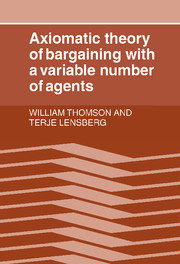Book contents
- Frontmatter
- Contents
- Acknowledgments
- List of symbols and notation
- List of axioms
- 1 Preliminaries
- 2 Axiomatic theory of bargaining with a fixed number of agents
- 3 Population Monotonicity and the Kalai–Smorodinsky solution
- 4 Population Monotonicity and the Egalitarian solution
- 5 Truncated Egalitarian and Monotone Path solutions
- 6 Guarantees and opportunities
- 7 Stability and the Nash solution
- 8 Stability without Pareto-Optimality
- 9 Stability and the Leximin solution
- 10 Population Monotonicity, Weak Stability, and the Egalitarian solution
- 11 Stability and Collectively Rational solutions
- 12 Invariance under Replication and Juxtaposition
- Bibliography
- Index
11 - Stability and Collectively Rational solutions
Published online by Cambridge University Press: 23 March 2010
- Frontmatter
- Contents
- Acknowledgments
- List of symbols and notation
- List of axioms
- 1 Preliminaries
- 2 Axiomatic theory of bargaining with a fixed number of agents
- 3 Population Monotonicity and the Kalai–Smorodinsky solution
- 4 Population Monotonicity and the Egalitarian solution
- 5 Truncated Egalitarian and Monotone Path solutions
- 6 Guarantees and opportunities
- 7 Stability and the Nash solution
- 8 Stability without Pareto-Optimality
- 9 Stability and the Leximin solution
- 10 Population Monotonicity, Weak Stability, and the Egalitarian solution
- 11 Stability and Collectively Rational solutions
- 12 Invariance under Replication and Juxtaposition
- Bibliography
- Index
Summary
Introduction
A major part of the theory of social choice is based on the assumption of collective rationality – that social decisions be made consistently with the maximization of some ordering on the space of alternatives, where by an ordering is meant a binary relation that is reflexive, transitive, and complete. For example, collective rationality is a defining property of an Arrow (1951) social welfare function (Arrow SWF), which produces social orderings of a given set of physical alternatives from profiles of individual orderings of those alternatives. Another well-known example is the family of Bergson–Samuelson social welfare functions (Bergson, 1938; Samuelson, 1947).
By a Bergson–Samuelson SWF is usually meant a real-valued function defined on utility space, representing a social ordering of all possible utility allocations for the society under consideration. As pointed out by Sen (1970, pp. 34–5), it is in general the social ordering itself that is of primary interest for social decision making. Therefore, any ordering of utility space will here be referred to as a Bergson–Samuelson SWF regardless of whether it has a real-valued representation.
Observe that the domain of definition of a Bergson–Samuelson SWF differs from that of an Arrow SWF: A Bergson–Samuelson SWF is defined on a space of utility allocations, whereas an Arrow SWF is defined on a space of individual orderings, for example, a space of utility functions.
A condition that is often imposed on the Bergson–Samuelson SWF is Separability, or Independence of Unconcerned Individuals, as it is also sometimes called.
- Type
- Chapter
- Information
- Axiomatic Theory of Bargaining with a Variable Number of Agents , pp. 153 - 185Publisher: Cambridge University PressPrint publication year: 1989



